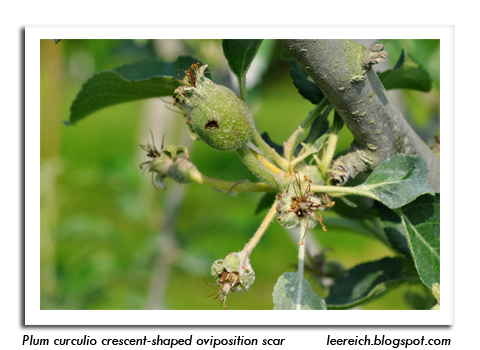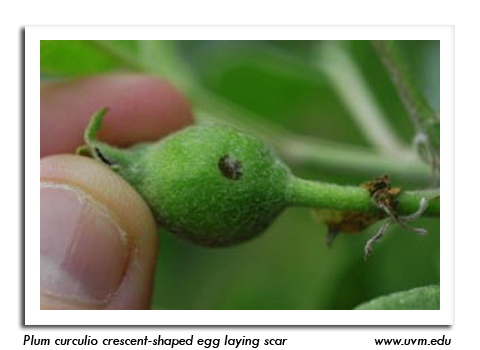
 |
|
|
Fruits
Volume 59 Number 6 Date 06/05/2014 CODLING MOTH - A significant increase in codling moth activity was charted in the last week. Counts varied from 0-62 per trap and averaged 13 per trap. Seven of the 25 reporting orchards registered very high counts of 20 or more moths per trap. The spring biofix has now been set in most southern Wisconsin orchards and growers should make preparations to apply controls at 250 degree days (base 50°F) from their specific biofix date. Treatment during this window is intended to eliminate most of the newly-hatched larvae before they enter fruits. PLUM CURCULIO - Beetle activity continued in southern and central orchards. Reports from Columbia and Racine counties indicate the first feeding and oviposition scars are appearing on apples and plums. According to Orchard IPM Specialist John Aue, examination of fruits for oviposition scars should be under way in apple orchards beyond petal fall, while sampling for adults using a beating tray is the preferred method for far northern orchards where tree development is less advanced. Female weevils show a strong preference for early-sizing apples and fruits beyond 10 mm will be most attractive. Organic control options include PyGanic (pyrethrin) applied at dusk to the outer rows and Surround WP (kaolin) on the interior trees. Both materials should be applied on a warm evening since most oviposition occurs at night. SPOTTED TENTIFORM LEAFMINER - Moth counts are expected to increase abruptly by mid-June as the second flight begins. Numbers this week were mostly low and ranged from 0-450 moths per trap, with an average of 46 per trap. This is the lowest average since the first flight began in early May. The economic threshold for STLM increases from 0.1 to 1.0 mine per leaf for the second generation of sapfeeder larvae. OBLIQUEBANDED LEAFROLLER - The first of two flights expected this season has begun in portions of southern Wisconsin with the accumulation of 600 degree days (base 43°F). Sampling of 10 fruit clusters and 10 terminals in the outsides, centers, and tops of five trees per orchard should occur on a weekly basis after pheromone traps indicate that emergence of spring moths has started. Control is warranted for populations averaging three or more larvae per tree. PLANT BUGS - Fruit growers can anticipate more plant bug adults appearing on apples, strawberries and other fruits as alfalfa harvesting accelerates next week. Nymphs are abundant in alfalfa sweep net collections, and could contribute to problems in fruit crops this month. LEAFROLLER - Larvae of an unidentified leafroller species, possibly RBLR or OBLR, were the cause of severe damage to apple trees in a north-central Wisconsin orchard. The grower observed leaves rolled together with webbing and silken threads, classic signs of leafroller activity. As noted, OBLR moths are beginning to emerge across southern Wisconsin, but most larvae in the central and northern areas are still in the intermediate to late-instars and could continue to damage apple foliage and expanding buds before pupation occurs. Chemical intervention may be justified for orchards experiencing significant leafroller pressure. -- Krista Hamilton, DATCP Entomologist 




|
|
|